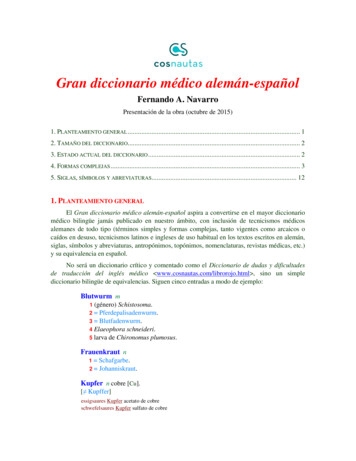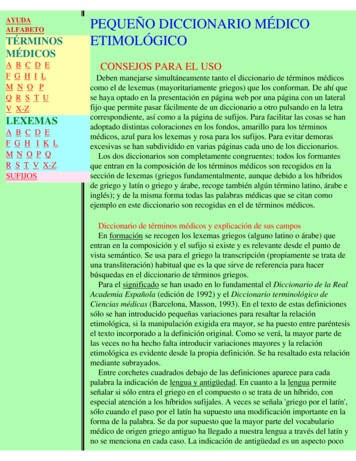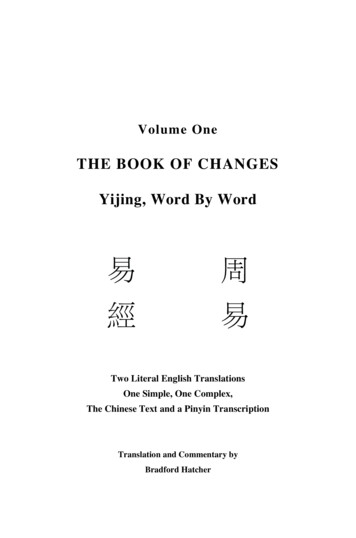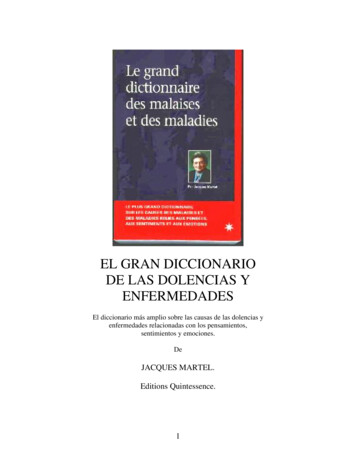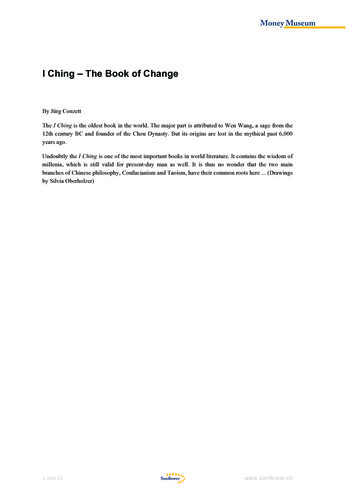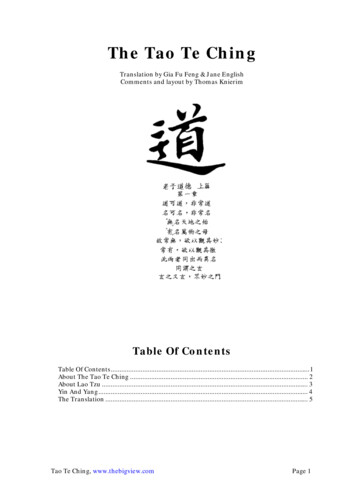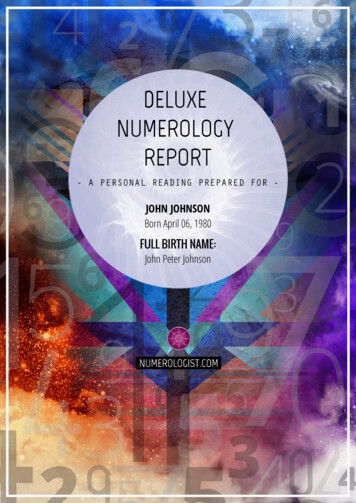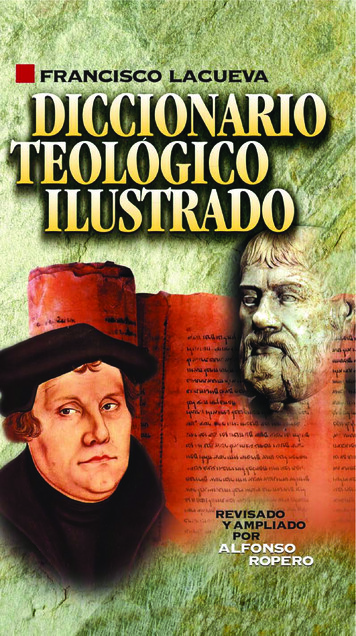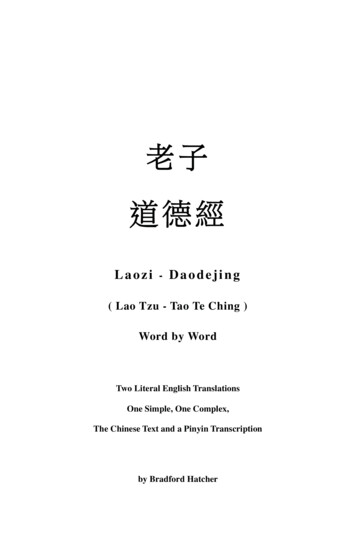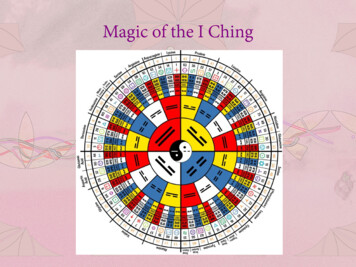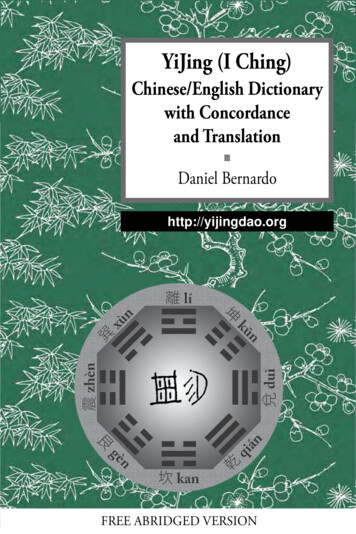
Transcription
YiJing (I Ching)Chinese/English Dictionarywith Concordanceand Translation Daniel Bernardohttp://yijingdao.orgFREE abridged VERSION
YiJing (I Ching)Chinese/English Dictionarywith Concordanceand Translation
YiJing (I Ching)Chinese/English Dictionarywith Concordanceand TranslationDaniel Bernardo
2012-2013 by Daniel C. BernardoAll rights reserved under International and Pan-American Copyright Conventions.ISBN 978-0-9916709-0-1http://yijingdao.orgFourth Edition: October 2013The cover image shows the arrangement of the trigrams in the HouTian (LaterHeaven) order, traditionally attributed to the King Wen. The South is at the top, following the traditional Chinese style. The two characters in the middle read ZhouYi.
ContentsContents.5Preface.7Introduction to the Translation. 11Introduction to the Dictionary. 13YiJing Translation. 15Dictionary. 145The Eight Trigrams. 263The Four Cardinal Virtues. 267Appendixes. 269Concordance. 271Bibliography. 309PinYin pronunciation. 311Chart of the Trigrams and Hexagrams. 313
PrefaceThe YiJing (or I Ching, when using the Wade-Giles romanization system) isa book from the Chinese Bronze Age (about 1000 BC) and as many other ancienttexts, it was written by a process of aggregation of material from different periodsand authors.By the time of the Han dynasty (206 BC to 220 AD) it became something similar to the text we know today as the “Classic of Changes” or “Book ofChanges” (易经). Of course, the interpretation of the text has changed overtime, but the ordering of the material has remained unchanged since the HanDynasty to the present.The Classic of Changes is composed of 64 short chapters, composed ofseveral elements and 10 appendixes, known as “The Ten Wings”.The parts of each chapter (commonly called hexagrams) are: A graphic symbol (卦 Gua), which is a drawing composed of six parallel lines, some filled and other broken. Example: G. A text that explains the meaning of the hexagram and whose first oneor two characters give it its name (卦辞 GuaCi), commonly called“The Judgment”. Short texts attached to each of the six lines (爻辞 YaoCi), except forthe hexagrams 1 and 2 that have seven texts. Several texts, from the Ten Wings: The Image (DaXiang), the TuanCommentary, etc.Composition of the text according to Chinese traditionLegend has it that FuXi (伏羲) designed the 64 hexagrams (hypotheticallyabout 3000 BC) and King Wen (周文王) wrote the texts that accompany eachhexagram, GuaCi, “The Judgment”.7
His son, the Duke Dan of Zhou (周公旦) added explanatory texts foreach line of the hexagrams.The texts due to King Wen and his son were know in his time (the BronzeAge in China) as ZhouYi (周易), “The Changes of the Zhou” being Zhou thename of the dynasty started by King Wen.Several hundred years later, the Confucian school added comments to thetext, which are known as the Ten Wings (十翼 ShiYi), and are divided into tenparts.These comments can be placed at the end of the text, as appendixes, orinserted into each hexagram, as is usually done with the commentary called “TheImage”, which comprises part of the Wings 3rd and 4th.Modern hypothesis about the origin of the textOn the origin of the hexagrams symbols and the texts that accompanythem there is no certainty, but it might be possible that the traditional story aboutthe composition of the text (The Judgment and the lines) is correct and thatKing Wen –which was a real historical figure– was the compiler of texts from theoracular tradition (circa 1000 BC), and that his son did something similar for thelines of the hexagrams.The Ten Wings come from various sources, some of them certainly are ofthe Confucian school, but it is not currently believed that they are a direct workfrom the hand of Confucius. Probably the Ten Wings were composed between200 BC and 200 A.D., during the Han dynastyEuropean translationsThe first translations from Chinese to Western languages were done byJesuits, who translated the text into Latin and French. Much later, during the nineteenth century English and French translations began to appear.The most prestigious of the English translations of the nineteenth centurywas that of James Legge; the following translation of importance (in German)was the one from Richard Wilhelm, which was published in 1924. Later, this sametranslation was translated into English by Cary Baynes, and published in 1950. Itremains the most popular English translation until today.Throughout the XX century many other translations appeared, but mostof them were only recombinations of previous versions but not true translations.In the last decades of the twentieth century several new English translations tried to shed light on the original meaning of the YiJing, going as far backto its origins as a document from the Bronze Age, trying to separate the layers ofthe original text to understand the original meaning of the earlier parts of the text.Some of them are the translations from Kunst, Rutt, Shaughnessy and Whincup;all of them attempt to elucidate the original meaning of the Chinese characters inthe earlier layers of the YiJing.8
Limitations of translations to Western languagesMost Chinese characters have a wide range of meanings, and its symbolicrichness makes them particularly suitable for oracular use. When translated intoanother language it is impossible to preserve the multiple meanings in the originaltext, because the translator is forced to choose words that cannot cover the fullrange of meanings of the Chinese characters.As an example, a common character (repeated 34 times) in the YiJing is悔, hui, commonly translated as “repentance.” That translation is not incorrect,but the word originally meant “problems.” Considering both meanings, the wordrefers to an objective situation and the internal reaction to it, but there is not anEnglish word that covers the two meanings.Another common word is 亨, heng, which appears 47 times, and means“success, achievement, satisfaction, growth, penetration, offering, sacrifice.” Anytranslation into a Western language will exclude some of those meanings. It isusually translated as “success” but that word does not cover the rich array ofmeanings of the original word.9
Introduction to the TranslationThis translation attempts to facilitate an approach to the YiJing originaltext*. It includes The Judgment (GuaCi) and the comments for the lines. From theTen Wings it only includes The Image (DaXiang).For each Chinese character it shows its pronunciation and its assignednumber, to allow finding it in the dictionary.The characters shown on a gray background at the start of each hexagramare the ones used as tag for each hexagram, which are the hexagram’s “title”. Mostof the hexagrams use a single character as tag, although some use two.This translation attempts to maintain balance between two extremes: A literal translation, which would be very difficult to understand, and; A translation of high literary level that for the sake of style would distort the meaning of the text.Since Chinese characters have gained new meanings but also lost somearchaic meanings, along the millennia, when possible, we choose words that coverboth the original and the newer meanings**, always inside the time frame from* The original text used for this translation is 周易折中 Zhouyi Zhezhong, “Balanced Comments on Zhouyi”, published in 1715 under the patronage of Qing Dynasty, is the same text used byWilhelm and many other sinologists as the basis of their translations.** A good example is the term in JunZi, 君子, which appears 73 times in the text. In manytranslations it is translated as “noble,” which captures well the range of meanings of JunZi, but insome versions it is translated as “superior man”, a term used by the Confucian school. It is notwrong to use the term “superior man”, but it restricts arbitrarily the range of meanings and leavesout the original meaning used by the author of the ZhouYi. Using “noble” is preferable because itcovers both the original (son of a lord) and and the newer (superior man) meanings.11
1000 BC to 200 AD, which was the approximate time when the Ten Wings wereended.The graphic layout of the Chinese characters was designed to reduce thespace occupied on the page, so that each hexagram can fit in two pages. Linebreaks are not significant.The Chinese characters indicating the numbering of the lines were omitted, because they do not add anything to the text’s meaning.12
Introduction to the DictionaryThe dictionaries of Chinese characters can be divided into two differenttypes: dictionaries of single characters and dictionaries of words (composed ofmultiple characters).Currently, most Chinese language words are composed of several characters, but in antiquity that was not the case.This dictionary is primarily a dictionary of characters, although it also explains many multi-character words.Unfortunately the Chinese characters do not have a single pronunciation;multiple characters may share the same sound. For example 悔 pronunciation ishui3, but also other 16 characters have the same pronunciation, and there are 127different characters that are pronounced hui, regardless of the accent (which isindicated by the number).For most of the twentieth century the Wade-Giles system was used to indicate how to pronounce Chinese characters. Wade-Giles is a romanization system,which shows the pronunciation with western letters. But in the last decades ofthe 20th century, the Pinyin pronunciation system (meaning “sound-spelling”) wasadopted by China and since then it prevailed almost universally.Pinyin uses four tones to indicate the pronunciation of each syllable, indicating the tone either with different accents (e.g., huī, huí, huǐ and huì) or withnumbers (e.g. hui1, hui2, hui3 and hui4).In this dictionary, the pronunciation of each character is indicated usingPinyin. The numbers shown in Pinyin syllables indicate the accent. The appendixon PinYin pronunciation has more information about this topic.The numbers assigned to the characters are the same used by the Mathew’sChinese-English dictionary. Notice that characters with numeration over 7773 are13
not included in Mathew’s dictionary. Also the numbers used by Karlgren’s Gram mata Serica Recensa dictionary are show for each character.The radical number and stroke count for each character are indicated aswell. This is useful when looking for the definition of a character in others dictionaries than Mathew’s or Karlgren’s, since locating characters by radical numberand stroke count is very common in Chinese dictionaries.The meaning of some Chinese characters has been maintained throughoutthe ages, but in many cases new meanings have been added and/or old meaningshave changed.In general, we have attempted to provide both the archaic and the modernmeanings. To avoid confusion anachronisms and modern meanings, not in use inthe past, are omitted.To indicate where characters are located in the text, the placement of thecharacters is shown by adding a point and a letter or number after the number ofthe hexagram.0indicates The Judgment;1 to 6 indicate a Line number;7indicates the comment for the cases when all lines change, in hexagramas 1or 2;Xindicates The Image.Characters included in this dictionaryThis dictionary includes all the characters found in The Judgment, TheImage and the lines. Although the image is of much later origin than the Judgment and lines (the texts known as ZhouYi), it has become common to include theimage next to the oldest texts and we follow that custom. In total the dictionaryincludes more than 900 characters, plus dozens of words composed of multiplecharacters.Since 1956 simplified characters are in use China, but this work shows onlythe traditional characters used for the last two millennia.Archaic characters are found in inscriptions on oracle bones (mostly fromthe Shang Dynasty). Other ancient characters can be found in archaic bronzes ofthe Shang and Zhou dynasties. In many cases these archaic character are shown inthe dictionary, below the normal ones, when they clarify the character’s originalmeaning.14
YiJing TRANSLATION
1. The Creative / Activity / Dynamic ForceJudgmentqian2 yuan2 heng1 li43233 7707 2099 3867元乾亨利zhen10346貞The Creative. Outstanding success. The determination is 68彊bu45379不xi12495息Heaven action is strong and dynamic.Thus the noble never ceases to strengthen himself.First Submerged dragon. Do not act.Second �li43867jian40860利見Dragon in the field. It is favorable to see the great man.Third �咎君夕子惕終若日厲乾乾The noble is active throughout the day.At night he is cautious, as if in danger. No defect.16da45943大ren23097人!
Fourth u27173jiu41192无咎Hesitates before jumping over the chasm. No defect.Fifth li43867利jian40860見da45943大ren23097人Dragon flying in the sky. It is favorable to see the great man.Top Arrogant dragon. There will be occasion for repentance.All lines are hou35839首ji20476吉A group of dragons without heads. Auspicious.17
2. The e Receptive. Outstanding success favorable for the determination of a mare.If the noble takes the lead he goes astray, but if he follows, he finds a master.It is favorable to find friends in the west and south;avoid friends in the east and north. A quiet determination is zai46653載wu47209物The earth condition is receptive obedience.Thus the noble, who has a munificent character, sustains all living creatures.First �zhi40982至Walking on hoarfrost one reaches hard ice.Second 22499習wu27173无bu45379不li43867利
Right, square and large, inexperienced.But nothing will be not favorable.Third g11500含章王可事貞无成或有從終Hidden brilliance; can be determined.If you’re still in the service of a king you will not have achievements,but will carry to conclusion.Fourth 3咎无yu47617譽A tied up bag. No defect, no praise.Fifth �Yellow lower garment.There will be outstanding happiness.Top xuan22881huang22297龍其戰血于玄野黃Dragons fight in the open country.Their blood is black and yellow.All lines are Sixli43867利yong37589永zhen10346貞Long term determination is favorable.19
The hexagrams 3 to 64 only are presentin the printed book.
dictionary
哀0003Karlgren: 550hPinYin: ai1Rad./Strokes: 30 6Grief, sorrow, regret; mourn, lament; to wail, to pity or have compassion for other person or oneself; alas!安0026Karlgren: 146aPinYin: an1Rad./Strokes: 40 3Quiet, at peace, calm; tranquility, safety,security; settled, comfort, contentment.Related with 7364 宴: feast, leisure,repose.占012501470182Karlgren: 618aPinYin: zhan1Rad./Strokes: 25 3Karlgren: 147rPinYin: zhan4Rad./Strokes: 62 12Battle, struggle, fight, war, combat;hostilities.Karlgren: 723aPinYin: zhang1Rad./Strokes: 117 6Brilliance, splendor, refinement, distinction; ornament, emblem of distinction, jade tablet; amulet.Its short form, with the jade radical,means “jade baton”.Wilhelm/Baynes translates it as lines, butmost other translators use words as el egancy, splendor, brilliant qualities, etc.張0195Divine by casting lots, prognosticating;observe signs; foretell by looking at anaugury or using yarrow wands (Achilleasibirica or mongolica).戰章Karlgren: 721hPinYin: zhang1Rad./Strokes: 57 8Draw taut (a bow), string the bow;stretch, extend. Has many other relatedmeanings but only the first ones arepertinent.From 弓, “bow” and 0213 長, phonetic.丈0200Karlgren: 722aPinYin: zhang4Rad./Strokes: 1 2Strong, mature, a married man; responsible; respectable; gentleman. One tobe respected.147
0213 - 0267長0213Karlgren: 721aPinYin: zhang3Rad./Strokes: 168 0Eldest, grown-up, senior, superior,leader, chief, maturity, tenured. Long,long lasting; tall.常0221Karlgren: 725ePinYin: chang2Rad./Strokes: 50 8Regular lot or duty; constant, always,lasting; perpetuate; frequent, regular,recurring; a rule or principle.鬯0232Karlgren: 719aPinYin: chang4Rad./Strokes: 192 0Aromatic spirits, libation, sacrificialspirits made up by fermenting millet(Panicum miliaceum) and fragrant herbs.Shows a chalice, and what is inside it;below there is a 5076 匕 sacrificialspoon.Older versions show clearly the chalicefilled with a libation:朝0233Karlgren: 1143aPinYin: zhao1Rad./Strokes: 74 8Morning, dawn, is the original meaning,but since the king held court at dawnand transacted state business early inthe morning, it also means audience.148昭0236Karlgren: 1131mPinYin: zhao1Rad./Strokes: 72 5Bright, brilliant, brightness of the sun;enlighten, display, show, manifest; illustrious.From 3124 日, “sun” and 召, “imperial decree; summon”, phonetic.Related with 0238 照.照0238Karlgren: 1131oPinYin: zhao4Rad./Strokes: 86 9Shine, illumine; enlighten; to look after.Related with 0236 昭, but adds “fire”2395 灬 (火) below 昭.巢0253Karlgren: 1169aPinYin: chao2Rad./Strokes: 47 8Nest, a nest in a tree; haunt, retreat,den.Shows a tree 4593 木, a nest 6362 田and feathers 1439 巛.The characters used for “nest” and“feathers” do not have such meanings,but that is what 巢 means.Older versions are more graphic:折0267Karlgren: 287aPinYin: zhe2Rad./Strokes: 64 4Sever, break; bend, destroy, execute;decide a cause, discriminate, judge.From 扌 (手), “hand” and 斤, “axe”.
0275 - 0327宅0275枕Karlgren: 780bPinYin: zhai2Rad./Strokes: 40 3Position, residence, dwelling, place forsettlement; inhabit; consolidate.From 宀, “house roof ” and 乇, phonetic.澤0277Karlgren: 790oPinYin: ze2Rad./Strokes: 85 13Marsh, pool, pond, lake; flat body ofwater and the vapors rising from it; enrich, fertilize, benefit; moist, moisten;glossy, polished.See 6560 兌 (the ideogram for TheLake trigram: h and 9000, The Trigrams).車02800313Karlgren: 455sPinYin: zhen4Rad./Strokes: 173 7Shock; clap of thunder; fear; awe inspiring; stimulation, movement, excitation; to excite, to terrify; to quicken;endow, succor.Related with 0313 振 and with the btrigram: The Arousing (Shock, Thunder) (Hex. 51). See 9000: The EightTrigrams.0327手,Karlgren: 455pPinYin: zhen4Rad./Strokes: 64 7Excite, shake, quake (Kunst), arouseaction; save help; arrange, to marshaltroops; to restore order.From 扌 (手), “hand” and 辰, phonetic.Related with 0315 震.臣Karlgren: 335cPinYin: che4Rad./Strokes: 64 8Drag, to trail, to hinder, obstruct.From 0986 制, “regulate” and“hand”.振0315See also 0398 乘: ride, mount.0282Pillow, to use as a pillow; rest, restingplace; stop, lean back on, soften, relax;a stake to tether cattle.Rutt, Kunst and Shaughnessy replace thischaracter with 沉: deep; to sink; toperish.震Karlgren: 74aPinYin: che1Rad./Strokes: 159 0Chariot, wagon, cart, carriage.Shows the wheels at the sides of thecarriage, older versions in bronze andbone also show the horses:掣0308Karlgren: 656gPinYin: zhen3Rad./Strokes: 75 4Karlgren: 377aPinYin: chen2Rad./Strokes: 131 0Servant, retainer, vassal, statesman, officer (41.6); male slave, male bondservant or may be a slave couple (33.3).7037 王臣: 39.2: king minister.1715 君臣: 62.2: prince minister.149
0346 - 0380貞0346Karlgren: 834gPinYin: zhen1Rad./Strokes: 154 2Perseverance, persistence, determination, steadiness, firmness; straight, correct, verified, certain; pure, loyal.This ideogram is the most repeated inthe YiJing and also one of the most important to understand the meaning ofthe text.In the last decades of the XX centurythe study of old oracular bone inscriptions shed new light on the originalmeaning of 貞.貞 defines the divination act. Originally meant “to determine an uncertain matter through divination”. Thisdetermination of the propitiousnessof external factors, with time changedto an interior determination, subjectivecommitment to do what is right (Kunst).The oldest character versions show ametal incense container in which thedivination cracks were made on oxshoulder blades (scapulimancy) or theunder-parts of turtle-shells (plastromancy) (See 3621 龜: turtle):貞 is also one of the “four cardinal virtues”: yuan heng li zhen: 7707 元 2099亨 3867 利 貞.See also 9001: The four cardinal virtues.It appears 111 times.正0351Karlgren: 833jPinYin: zheng4Rad./Strokes: 77 1Correct, proper, upright, straight; correct, regulate, chief, ruler; just, exactly.150征0352Karlgren: 833oPinYin: zheng1Rad./Strokes: 60 5Punishing expedition (“to correct”), toreduce to submission, attack, punish,attack; to levy taxes; comes, brings.征吉 0476: brings good fortune(appears at: 11.1, 46.0, 47.6, 49.2and 54.1).征凶 2808: brings misfortune (appears at: 9.6, 27.2, 34.1, 41.2, 47.2,49.3, 49.6, 51.6, 54.0 and 64.3).政0355Karlgren: 833rPinYin: zheng4Rad./Strokes: 66 5; 66 4Standard, law (civil, not criminal), regulation, government.From 0351 正, “correct” and 攵 (攴), “beat”.See also 7685 獄: criminal lawsuits.拯0360Karlgren: 896iPinYin: zheng3Rad./Strokes: 64 6Relief, rescue, to lift up, to raise; geld,remove (Kunst, Rutt).成0379Karlgren: 818aPinYin: cheng2Rad./Strokes: 62 2; 62 3Accomplish, achieve, finish, completea task, fulfill; completed, perfect, fullydeveloped, mature; peace making.城0380Karlgren: 818ePinYin: cheng2Rad./Strokes: 32 6City walls; battlements, place fortifiedfor defence; city, citadel.
0383 - 0429稱0383Karlgren: 894gPinYin: cheng1Rad./Strokes: 115 9Evaluate, weigh, assess, appraise.From 禾, “grain” and 爯, “a 爫 handholding 冉 scales”: weighing the grain.懲0384Karlgren: 891bPinYin: cheng2Rad./Strokes: 61 15Restrain, curb; correct, chastise, reprimand, corrective punishment; awarning.承0386Karlgren: 896cPinYin: cheng2Rad./Strokes: 64 4 Support (12.2, 32.3). Assist, bear, serve, to present (54.6). Receive, inherit: 承家 0594 (7.6).乘0398箕0402Although this character means winnowing basket, sieve, separate grainfrom chaff, winnow, it is also the nameof an ancient Shang State and the nameof a prince or viscount.It only appears in 36.5 along with othercharacter:箕子6939: Jizi, Viscount Ji was aminister, and the uncle of the lastShang king. He was imprisoned forrefusing to serve as minister andreproaching the king for his badactions. It is told that he simulatedmadness to keep his life.幾0409Karlgren: 895aPinYin: cheng2Rad./Strokes: 4 9Ride (40.3), mount, ascend, climb up(13.4).乘馬 4310: a team of four horses(3.2, 3.4, 3.6).Riding horses was not practised untilthe fifth century BC in China, long after the ZhouYi was written; before thenhorses were only used to draw chariotsand carriages.乘 is the image of a war chariot. Seealso 0280 車. An ancient representation is shown below:Karlgren: 952fPinYin: ji1Rad./Strokes: 118 8Karlgren: 547aPinYin: ji1Rad./Strokes: 52 9Almost; imminent, nearly; occasion;minutiae, first subtle signs; approaches.机0411Karlgren: 602cPinYin: ji1Rad./Strokes: 75 2Support, stool, low or small table.己0429Karlgren: 953aPinYin: ji3Rad./Strokes: 49 0Self, oneself, personal, private.Cyclic character. 6th heavenly stem.See 2915 旬: the ten days week.Wilhelm replaces 559041.1 and 49.0.巳 with 己 in151
The Dictionary entries for the characters numberedfrom 432 to 8011 only are presentin the printed book.
9000The Eight TrigramsEach hexagram can be divided into twotrigrams, which are groups of threeconsecutive lines, either the lower orthe upper three lines. There are onlyeight trigrams, which are called ba gua,八卦 (ba means eight) because thereare only eight ways to combine brokenand whole lines in groups of three.Although tradition tells us that the trigrams preceded the hexagrams, thereis no proof of that. They may havebeen abstracted from the hexagramssomething between the creation of theZhouYi text (comprising The Judgmentand the lines) and the composition ofthe Ten Wings, which mention the trigrams.The names of the eight trigrams referto the natural elements: Qian (Heaven),Kun (Earth), Zhen (Thunder), Kan (Water), Gen (Mountain), Xun (Wind orWood), Li (Fire) and Dui (Lake).It is important to understand the symbolic meanings of each trigram, andhow they relate to each other to comprehend better the main idea of thehexagrams.The image at the top of the next column shows the arrangement of thetrigrams in the Inner-World (LaterHeaven), arrangement, which is traditionally attributed to king Wen, and isthe one used in the Eight Wing, theShuoGua, which also provides mostof the meanings for the trigrams. TheSouth is at the top, following the traditional Chinese style. The two oraclebones characters in the middle readZhouYi.The creative /The Heavena-乾3233Heaven symbolizes strength and is thebeginning of all things.Related trigram: e, the mother.Action: Rules.Pronunciation: Quian2.Natural symbol: Heaven.Member of the family: The father.Body part: The head.Animals: A good horse, an old horse, athin horse, a wild horse, a piebaldhorse.Season: Autumn.Color: Deep red.Cardinal points: North-West.Other associations: A circle; a ruler, aprince; strength, hardness; strongmovement, tireless work; jade; metal; cold; ice; the fruits from trees.God strives in a. It means that Yang andYin interact, stimulating each other.263
9000The receptive /The Earthe -坤3684Earth symbolizes gentleness and nourishes all beings.Related trigram: a, the father.Action: Serves, nourishes.Pronunciation: Kun1.Natural symbol: Earth, black soil.Member of the family: The mother.Body part: The belly.Animal: Cow and calf; a heifer; a youngmare.Season: Summer.Color: Yellow.Cardinal points: South-West.Other associations: Cloth, a kettle, parsimony, a turning lathe, a large wagon,variegated things, a multitude, quantity, a handle and support; frugality,thrift, passionate delivery, devotion,protection, selflessness, generosity,gentleness, ductility, the number 10.God is served in e.The arousing /The thunderb-震0315The Thunder symbolizes movementand speed.Related trigram: f, the eldest daughter,because Thunder and Wind do not264hinder one another, but they exciteeach other.Action: Arouses, shakes, stirs, put thethings in movement.Pronunciation: Zhen4.Natural symbol: The thunder, wood.Member of the family: The eldest son.Body part: The feet, because they servefor movement.Animal: The dragon; horses that neighwell, have white hind legs, aresprightly, or have a white star on theforehead.Season and time: Spring, dawn.Color: Dark yellow; violet blue and yellow; dark and pale.Cardinal point: East.Other associations: Development; a greathighway; vehement decisions; greenbamboo shoots; reeds and rushes;in respect to cultivated plants it isthose that grows back to life fromits disappearance (like legumes);what in the end becomes the strongest and most luxuriant.God comes forth in b.The gentle / The windf -巽5550The Wind symbolizes penetration.Related trigram: b, the eldest son, because Wind and Thunder do nothinder one another, but they exciteeach other.Action: Scatters (the seeds of) the things.Pronunciation: Xun4.Natural symbol: The wind, wood.
9000Member of the family: The eldest daughter.Body part: The thighs; deficiency ofhair; broad forehead; much white inthe eye; crooked eyes.Animal: The cock, fowl.Season: Spring.Color: White.Cardinal points: South-East.Other associations: Firewood; a plumbline; a carpenter’s square; long; lofty;advancing and receding; unresolved;strong scents; the close pursuit ofgain, those who get nearly threefoldin profit; work, business; a fair; a tendays cycle; at the end point of itsdevelopment it becomes Zhen (TheThunder).God sets all things in order in f.The Abysmal /The waterc-坎3245The Water is the symbol of what is precipitous and perilous.Related trigram: g the middle daughter,because Water and Fire do not failto complement each other.Action: Moistens.Pronunciation: Kan3.Natural symbol: Water, clouds, river,Moon.Member of the family: The middle son.Body part: The ears.Animals: Pig; fox; horses with beautiful backs, with high spirit, with adrooping head, with thin hooves,who shamble along.Season: Winter.Color:
The YiJing (or I Ching, when using the Wade-Giles romanization system) is a book from the Chinese Bronze Age (about 1000 BC) and as many other ancient texts, it was written by a process of aggregation of material from different periods and authors. By the t
